Japanese Gallery (Honkan)
January 2, 2015 (Fri) - January 12, 2015 (Mon)
Features selected masterpieces from our collection to celebrate the new year.
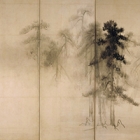
Pine Trees (detail), By Hasegawa Tohaku, Azuchi-Momoyama period, 16th century (National Treasure)
Japanese Gallery (Honkan)
January 2, 2015 (Fri) - January 12, 2015 (Mon)
Features selected masterpieces from our collection to celebrate the new year.
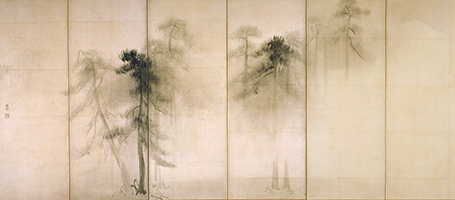
Hasegawa Tohaku painted Pine Trees in bold and rough brushwork using several brushes combined together and a bamboo stick with a split end. With shades of ink to present different degrees of illumination, the artist created a quiet grove of pine trees where shadows appear and disappear in swirling mist.
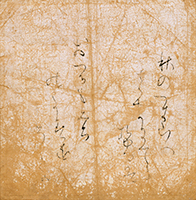
Attributed to Ki no Tsurayuki, Heian period, 11th century (Important Cultural Property, Gift of Mr. Asano Nagatake)
Room 3, Honkan
January 2 - 12, 2015
Written on decorated paper imported from China and stored at the Sunshoan sub-temple of Daitokuji temple, this page originally came from a poetry anthology that included seasonal poems from the Kokinwakashu. This page features a poem relating to the autumn moonlight and maple leaves.
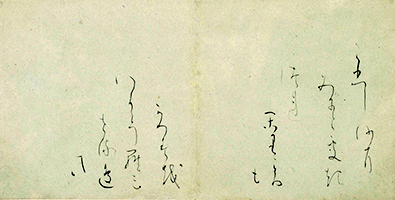
Known as the Tsugi-shikishi (joined shikishi paper), this is a segment from a poetry book. The book was bound in detcho style, where paper sheets are folded in two, and the folded edges are glued together. A waka poem is written on the inside of the folded paper. While some of the poems from the book are known to have been selected from famous poetry anthologies, the source of this piece is not known.
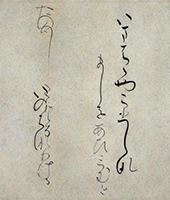
Attributed to Fujiwara no Kozei, Heian period, 11th century
Room 3, Honkan
January 2 - 12, 2015
With elaborate scattered writing in sophisticated calligraphic style, Tsugi-shikishi segments and shikishi segment groups from two other poetry books, known as Masu-shikishi and Sunshoan-shikishi, are referred to as the "Three Shikishi".
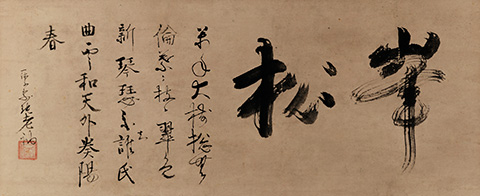
The monk Ikkyu Sojun led a checkered life in a tumultuous era of battles, severely criticizing the authorities and power holders through his eccentric and depraved acts. Among his many writings which remain today, this work is presumably from his later years.
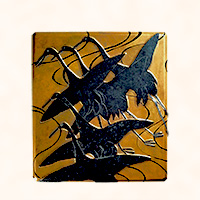
Edo period, 18th century (Gift of Mr. Matsunaga Yasuzaemon)
Room 8, Honkan
November 26, 2014 - February 22, 2015
This writing box has a golden surface created by a dense application of gold dust. The flowing water pattern runs from the top of the lid to the sides, while the cranes are depicted with lead inlay. A composition featuring large motifs that fill the surface and the bold use of thick pieces of lead are features influenced by the maki-e style of Ogata Korin, a brilliant painter and designer.
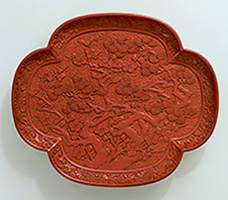
By Tsuishu Yozei, Edo period, 18th century
Room 8, Honkan
November 26, 2014 - February 22, 2015
The tradition of tsuishu lacquer carving was passed on in the Tsuishu Yozei family from the medieval Muromachi period to the modern era, by the generations succeeding Yozei Nagamitsu, who was the first to make works of tsuishu carving in Japan. After the eighth-generation head received orders from Tokugawa Iemitsu, the family was appointed by the shogunate family throughout the Edo period.
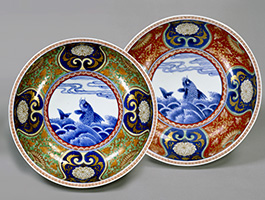
Imari ware, Edo period, 17th - 18th century
Room 8, Honkan
November 26, 2014 - February 22, 2015
Metal techniques that resulted in designs expressed in gold flakes or powder on ceramics were developed in Jingdezhen, China during the late Ming period. These techniques were imported to Japan and used for Imari ware, bold ceramics meant for domestic use, during the Genroku era. This bowl displays highly advanced metal techniques on a red and yellow green ground - two colors that reflect the aesthetics of the Genroku era.

Mitsuhiro was a noble at the start of the Edo period. He excelled in study of the Kokin wakashu poetry anthology and was well-known as a poet. As a link between the imperial court in Kyoto and the Tokugawa shogunate in Edo (now Tokyo), he often traveled from Kyoto to Edo. This diary is based on his travel journals, with added poems and sketches. The unique style of calligraphy is from his later years.
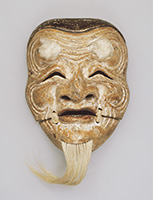
Muromachi period, 15th - 16th century
Room 9, Honkan
November 26, 2014 - January 25, 2015
The dances of the Noh play, Okina, are strongly connected to Shinto rites that pray for good harvests and the prosperity of descendants. Technical features of this mask include eyes shaped to indicate a smile, thick eyebrow tufts, an implanted beard, and a separable jaw bound by string. The arching cheekbones and pronounced nose are attractive elements of the sculptural style.
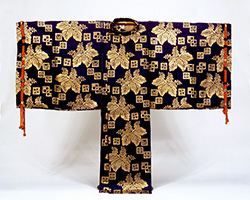
Edo period, 18th century
Room 9, Honkan
November 26, 2014 - January 25, 2015
Kariginu were originally a type of garment worn by aristocrats of the imperial court for travel or recreational hunting. They have drawstrings around the sleeves and are open at the armpits for ease of movement. In Noh, kariginu are used for roles portraying individuals of high status, such as emperors and ministers, as well as gods. Paulownia trees, on which the legendary Chinese phoenix roosts, are symbols of nobility.
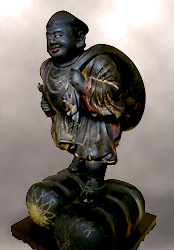
By Kaiken Formerly owned by Todai-ji, Nara, Nanbokucho period, dated 1347 (Important Cultural Property, Lent by Agency for Cultural Affairs)
Room 11, Honkan
November 26, 2014 - February 22, 2015

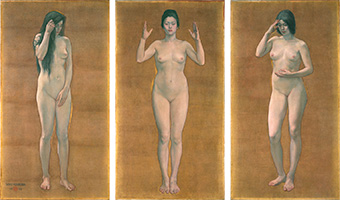
By Kuroda Seiki, 1899
Special Room, Kuroda Memorial Hall
January 2 - 12, 2015
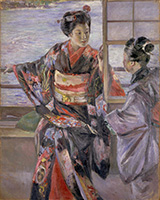
By Kuroda Seiki, 1893 (Important Cultural Property)
Special Room, Kuroda Memorial Hall
January 2 - 12, 2015
This work is considered as the first painting by Kuroda after his stay in France. Maiko girl sitting on the bow window is depicted with bright surface of the Kamogawa river behind. The light comes from behind Maiko. The model was Koen of Ono-tei. The shallow water flow of the river seems like corresponding to Maiko's mind.
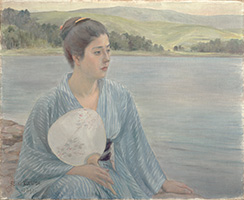
By Kuroda Seiki, 1897 (Important Cultural Property)
Special Room, Kuroda Memorial Hall
January 2 - 12, 2015
This work was painted at the Lake Ashino-ko in Hakone. Mrs. Kuroda who sat as model of this work wrote that this painting was started when Kuroda had been studying depicting water at the lakeside. The pattern and color of her Kimono reflects the expression of the water. Also, silent water and calm face of the lady correspond to each other.
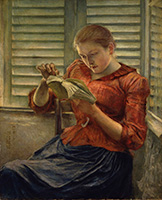
By Kuroda Seiki, 1891
Special Room, Kuroda Memorial Hall
January 2 - 12, 2015
Women reading books represented a sophisticated, affluent life, and they were a popular subject of paintings in the 19th century. Kuroda worked on this painting from 1890 to 1891 in Grez-sur-Loing in the suburbs of Paris, with Maria Billault as the model. Reading was submitted to the Salon in 1891 and became Kuroda's first work to be exhibited there.
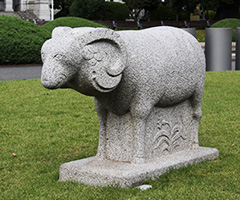
From Gangwondo, Korea, Joseon dynasty, 18th - 19th century
Outdoor Exhibits
On exhibit through the year